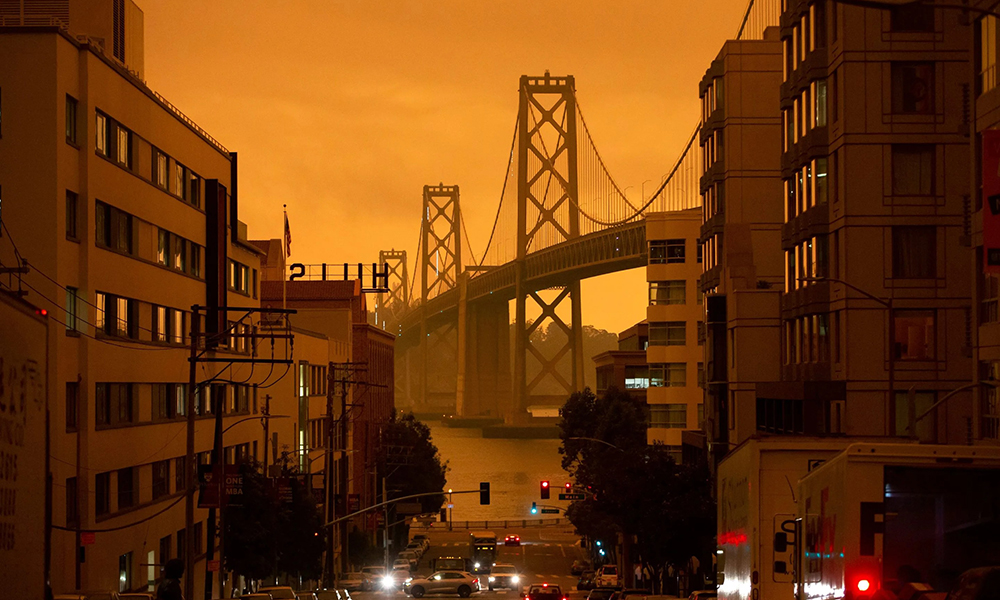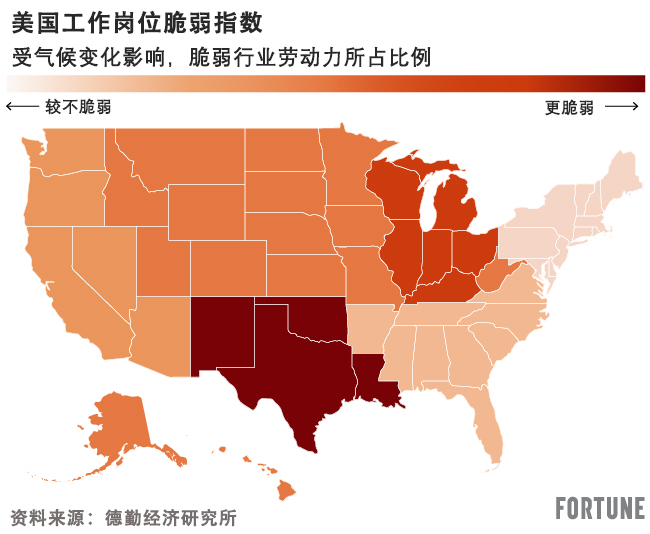
贾斯汀·哈丁在Slack工作三天后,美国进入了封城状态。很快,他的家乡面临着另一场危机,附近野火肆虐。
“我自学编程是为了改变世界。”哈丁说,他现在是气候相关工作求职网站Climatebase的联合创始人和首席技术官。“然后砰的一声,旧金山的天空变成了橙色,我当时就想,到底发生了什么?”
当哈丁开始他的技术生涯时,他曾希望利用他的软件工程背景来改变世界。但他的大部分工作都集中在广告产品上。一个偶然的机会,他偶然发现了Climatebase的第一届气候相关工作招聘大会,在那里他结识了联合创始人埃文(Evan)和杰西·海因斯(Jesse Hynes)兄弟。他说:“这让我大开眼界。”我意识到,作为一名软件工程师,我可以在这个领域产生影响力,并真正为有意义的事情写代码。"
像哈丁一样,许多美国人也加入了日益壮大的气候行业。这是就业市场的一个蓬勃发展的领域,在那里他们感受到了经济机遇和大展宏图的机会。推动这种增长的是许多企业在应对气候危机时所经历的演变。IDEO合伙人兼董事总经理布莱恩·沃克(Bryan Walker)认为,企业现在正进入气候时代。
沃克说:“气候,就像之前的互联网一样,将引发巨变,并带来深远影响,企业将不得不重新设定发展路线。”
“绿领”工作的兴起
根据德勤的一份报告,由于气候变化和向净零排放的转变,全球超过8亿个工作岗位“高度脆弱”。德勤全球人力资本业务负责人阿特•马佐尔(Art Mazor)指出,其中超过1300万个工作岗位在美国。

全球工作岗位脆弱指数
受气候变化影响,脆弱行业劳动力所占比例
较不脆弱
更脆弱
美洲
非洲
亚太地区
资料来源:德勤经济研究所
《财富》杂志
“这种脆弱性并不意味着工作岗位在消失。”马佐说。“工人将需要提高技能、重新学习技能或进行调整。”
到2050年,预计将新增3亿多个“绿领”工作岗位,而让劳动力过渡到具备这些岗位所需的技能是一项艰巨的任务。
德勤的研究显示,有两条可能的转型之路:一条是被动的,一条是主动的。被动的转型之路将看到世界各地的企业实现净零排放,但政策和劳动力无法协同一致来实现这一目标。

美国工作岗位脆弱指数
受气候变化影响,脆弱行业劳动力所占比例
较不脆弱
更脆弱
资料来源:德勤经济研究所
《财富》杂志
马佐指出:“我们最终将面临严重的工人技能和工作岗位不匹配,最终限制低排放行业和经济的增长。”他补充说,主动的转型之路将带来“更快速的经济增长。我们更容易实现净零排放,员工也有明确的职业发展道路。”
数据显示,该行业已经在快速增长,至少在需求方面是这样。根据领英(LinkedIn)的数据,绿色工作岗位的需求增长了40%。Climatebase的埃文·海因斯表示,该公司网站上发布的54000多个职位已经有近100万人申请。
海因斯说:“仅仅在过去的30天里,就有6000多份申请递交到了这个网站。坦率地说,我们看到了巨大增长,我确实认为这是因为我们看到了来自科技企业和金融等更传统领域的工作人员来申请。”
辞职、裁员推动了这场“大调整”
随着全国各地越来越多的科技公司裁员,预计更多的求职者将进入气候领域。总部位于波士顿的气候人才招聘公司Climate People的创始人布兰登·安德森(Brendan Andersen)指出,这些工作的地点也可能会发生转变。他说,随着该行业的发展,波士顿、纽约、休斯顿、硅谷和洛杉矶将成为气候工作的热点地区。
安德森花了四年时间试图找到一家专注于绿色或清洁技术工作岗位招聘的招聘公司,然后他自己创办了一家这样的公司。
“对很多人来说,转折点是风暴越来越强,水位越来越高,干旱时间更长,野火更猛烈,到处都在发生这种情况。当人们看到这一点时,就会呼吁采取行动。”
企业也看到了人们呼吁采取行动,IDEO的沃克表示:“新客户群有不同的价值观,新员工群也有非常不同的价值观,而且在这个领域已经有足够多的投资,如今,实际上有真正的技术可以投资和用来扩大规模。我认为,这在很大程度上有助于从基于价值的对话转向实际上基于业务的对话。”
“气候,就像之前的互联网一样,将引发巨变,并带来深远影响,企业将不得不重新设定发展路线。”
——布莱恩•沃克,IDEO合伙人兼董事总经理
安德森也认为,公司需要认识到求职者优先次序的变化,才能更好地吸引人才。
他说:“员工想知道公司的使命和影响力。这是巨大的转变,直接归因于年轻一代对事物的优先次序的考虑非常不同。”
Climatebase的埃文·海因斯称这是工作的“大调整”。他说:“我们看到的是大辞职潮期间,人们精疲力竭。现在我们看到了大规模的裁员。在这两个时刻,都有大量新人才进入气候就业市场。”他说。“大辞职潮和大裁员潮之后的下一个阶段是大调整。”
马佐表示,劳动力人口结构的变化,以及对美国机构信任的转变,也推动了向气候工作的转变。7月,盖洛普(Gallup)公布的年度民意调查显示,人们对美国机构的总体信心跌至历史最低点。Edelman Institute在过去20年里一直在跟踪公众对企业、政治和媒体的信任度,该研究所也发布了一份报告,该报告显示企业现在比以往任何时候都要承担更大的社会责任。
气候工作的下一个趋势是什么
如果气候变化真的是下一个互联网繁荣,那么问题是,这种变化会持续下去吗?答案似乎是肯定的。
马佐指出:“即使是石油、天然气和化学工业等行业的领军者,也在采取非常明确的立场,并在商业模式上做出转变。”
“大辞职潮和大裁员潮之后的下一个阶段是大调整。”
——埃文·海因斯,Climatebase首席执行官兼联合创始人
经济衰退的可能性会影响气候相关就业市场。沃克警告说,企业可能会犹豫是否进行商业战略的重大转变,并抓住可再生能源等新机遇。
“这会改变商界领袖之间的对话吗?”他们会放松油门吗?他想知道,尽管他仍然相信,人们在气候意识方面的思维方式发生了更持久的转变。“我认为,这将成为企业和社会必须重新设定发展路线的主导环境。”(财富中文网)
译者:中慧言-王芳
贾斯汀·哈丁在Slack工作三天后,美国进入了封城状态。很快,他的家乡面临着另一场危机,附近野火肆虐。
“我自学编程是为了改变世界。”哈丁说,他现在是气候相关工作求职网站Climatebase的联合创始人和首席技术官。“然后砰的一声,旧金山的天空变成了橙色,我当时就想,到底发生了什么?”
当哈丁开始他的技术生涯时,他曾希望利用他的软件工程背景来改变世界。但他的大部分工作都集中在广告产品上。一个偶然的机会,他偶然发现了Climatebase的第一届气候相关工作招聘大会,在那里他结识了联合创始人埃文(Evan)和杰西·海因斯(Jesse Hynes)兄弟。他说:“这让我大开眼界。”我意识到,作为一名软件工程师,我可以在这个领域产生影响力,并真正为有意义的事情写代码。"
像哈丁一样,许多美国人也加入了日益壮大的气候行业。这是就业市场的一个蓬勃发展的领域,在那里他们感受到了经济机遇和大展宏图的机会。推动这种增长的是许多企业在应对气候危机时所经历的演变。IDEO合伙人兼董事总经理布莱恩·沃克(Bryan Walker)认为,企业现在正进入气候时代。
沃克说:“气候,就像之前的互联网一样,将引发巨变,并带来深远影响,企业将不得不重新设定发展路线。”
“绿领”工作的兴起
根据德勤的一份报告,由于气候变化和向净零排放的转变,全球超过8亿个工作岗位“高度脆弱”。德勤全球人力资本业务负责人阿特•马佐尔(Art Mazor)指出,其中超过1300万个工作岗位在美国。
全“这种脆弱性并不意味着工作岗位在消失。”马佐说。“工人将需要提高技能、重新学习技能或进行调整。”
到2050年,预计将新增3亿多个“绿领”工作岗位,而让劳动力过渡到具备这些岗位所需的技能是一项艰巨的任务。
德勤的研究显示,有两条可能的转型之路:一条是被动的,一条是主动的。被动的转型之路将看到世界各地的企业实现净零排放,但政策和劳动力无法协同一致来实现这一目标。
马佐指出:“我们最终将面临严重的工人技能和工作岗位不匹配,最终限制低排放行业和经济的增长。”他补充说,主动的转型之路将带来“更快速的经济增长。我们更容易实现净零排放,员工也有明确的职业发展道路。”
数据显示,该行业已经在快速增长,至少在需求方面是这样。根据领英(LinkedIn)的数据,绿色工作岗位的需求增长了40%。Climatebase的埃文·海因斯表示,该公司网站上发布的54000多个职位已经有近100万人申请。
海因斯说:“仅仅在过去的30天里,就有6000多份申请递交到了这个网站。坦率地说,我们看到了巨大增长,我确实认为这是因为我们看到了来自科技企业和金融等更传统领域的工作人员来申请。”
辞职、裁员推动了这场“大调整”
随着全国各地越来越多的科技公司裁员,预计更多的求职者将进入气候领域。总部位于波士顿的气候人才招聘公司Climate People的创始人布兰登·安德森(Brendan Andersen)指出,这些工作的地点也可能会发生转变。他说,随着该行业的发展,波士顿、纽约、休斯顿、硅谷和洛杉矶将成为气候工作的热点地区。
安德森花了四年时间试图找到一家专注于绿色或清洁技术工作岗位招聘的招聘公司,然后他自己创办了一家这样的公司。
“对很多人来说,转折点是风暴越来越强,水位越来越高,干旱时间更长,野火更猛烈,到处都在发生这种情况。当人们看到这一点时,就会呼吁采取行动。”
企业也看到了人们呼吁采取行动,IDEO的沃克表示:“新客户群有不同的价值观,新员工群也有非常不同的价值观,而且在这个领域已经有足够多的投资,如今,实际上有真正的技术可以投资和用来扩大规模。我认为,这在很大程度上有助于从基于价值的对话转向实际上基于业务的对话。”
“气候,就像之前的互联网一样,将引发巨变,并带来深远影响,企业将不得不重新设定发展路线。”
——布莱恩•沃克,IDEO合伙人兼董事总经理
安德森也认为,公司需要认识到求职者优先次序的变化,才能更好地吸引人才。
他说:“员工想知道公司的使命和影响力。这是巨大的转变,直接归因于年轻一代对事物的优先次序的考虑非常不同。”
Climatebase的埃文·海因斯称这是工作的“大调整”。他说:“我们看到的是大辞职潮期间,人们精疲力竭。现在我们看到了大规模的裁员。在这两个时刻,都有大量新人才进入气候就业市场。”他说。“大辞职潮和大裁员潮之后的下一个阶段是大调整。”
马佐表示,劳动力人口结构的变化,以及对美国机构信任的转变,也推动了向气候工作的转变。7月,盖洛普(Gallup)公布的年度民意调查显示,人们对美国机构的总体信心跌至历史最低点。Edelman Institute在过去20年里一直在跟踪公众对企业、政治和媒体的信任度,该研究所也发布了一份报告,该报告显示企业现在比以往任何时候都要承担更大的社会责任。
气候工作的下一个趋势是什么
如果气候变化真的是下一个互联网繁荣,那么问题是,这种变化会持续下去吗?答案似乎是肯定的。
马佐指出:“即使是石油、天然气和化学工业等行业的领军者,也在采取非常明确的立场,并在商业模式上做出转变。”
“大辞职潮和大裁员潮之后的下一个阶段是大调整。”
——埃文·海因斯,Climatebase首席执行官兼联合创始人
经济衰退的可能性会影响气候相关就业市场。沃克警告说,企业可能会犹豫是否进行商业战略的重大转变,并抓住可再生能源等新机遇。
“这会改变商界领袖之间的对话吗?”他们会放松油门吗?他想知道,尽管他仍然相信,人们在气候意识方面的思维方式发生了更持久的转变。“我认为,这将成为企业和社会必须重新设定发展路线的主导环境。”(财富中文网)
译者:中慧言-王芳
The orange-smoke-filled sky in San Francisco inspired Justin Hardin to join Climatebase.
BRITTANY HOSEA-SMALL—AFP VIA GETTY IMAGES
Three days after Justin Hardin started his job at Slack, the country went into lockdown. Soon, his hometown was facing another crisis as wildfires raged nearby.
“I taught myself to code to change the world,” said Hardin, who is now a cofounder and the chief technology officer of the climate job board Climatebase. “Then boom, the skies in San Francisco turned orange, and I was like, what in the world is happening?”
When Hardin started his tech career, he had hoped to use his software engineering background to change the world. But most of his work was focused on ad products. By chance, he stumbled upon Climatebase’s first Climate Career Fair, where he connected with cofounders and brothers Evan and Jesse Hynes. “That opened my eyes,” he said. “I realized that as a software engineer, I can have an impact in this space and actually code for good.”
Like Hardin, many Americans are joining the growing climate sector. It’s a booming area of the job market where they sense economic opportunity and a chance to make a difference. What’s driving this growth is the evolution many businesses are undergoing as they respond to the climate crisis. Bryan Walker, a partner and managing director at IDEO, believes that businesses are now entering the climate era.
“Climate, like the internet before it, will cause a huge, seismic change that businesses are going to have to reconfigure themselves around,” Walker said.
The rise of ‘green-collar’ jobs
According to a Deloitte, more than 800 million jobs around the world are “highly vulnerable” due to climate change and the move toward net-zero. More than 13 million of them are in the U.S., notes Deloitte Global Human Capital Practice Leader Art Mazor.
GLOBAL JOB VULNERABILITY INDEX
SHARE OF WORKFORCE IN VULNERABLE INDUSTRIES DUE TO CLIMATE CHANGE
LESS VULNERABLE
MORE VULNERABLE
AMERICAS
AFRICA
ASIA PACIFIC
SOURCE: DELOITTE ECONOMICS INSTITUTE
FORTUNE
“The vulnerability doesn’t mean the jobs are going away,” Mazor said. “Workers will need upskilling, reskilling, or adjustment.”
More than 300 million additional “green-collar” jobs are expected to emerge by 2050, and transitioning the workforce to have the skills needed to perform in these roles is a big undertaking.
Deloitte’s research shows that there are two possible paths of transition: one passive and one active. The passive path will see corporations worldwide achieve net-zero, but policy and the workforce won’t work in concert to get there.
U.S. JOB VULNERABILITY INDEX
SHARE OF WORKFORCE IN VULNERABLE INDUSTRIES DUE TO CLIMATE CHANGE
LESS VULNERABLE
MORE VULNERABLE
SOURCE: DELOITTE ECONOMICS INSTITUTE
FORTUNE
“We’ll end up with a terrible skills and jobs mismatch which ends up limiting the growth of low emissions sectors and economies,” Mazor noted. He adds that the active path will yield “a more rapid growth of the economy. We get to net-zero more readily, and the workforce has a clear path forward.”
Data suggests that the sector is already rapidly growing, at least on the demand side. According to LinkedIn, demand for green jobs has grown by as much as 40%. Evan Hynes of Climatebase says the company has had nearly 1 million people apply for the more than 54,000 jobs posted on the site.
“Just in the last 30 days, over 6,000 applications went through the site,” Hynes said. “We are seeing tremendous growth, to put it plainly, and I do think it’s because we’re seeing folks from more traditional areas of tech business and finance.”
Resignations, layoffs drive the ‘great realignment’
As more tech layoffs take place across the country, it’s expected that more of these job seekers will move into the climate space. As Brendan Andersen, the founder of Climate People, a climate talent recruiting firm based in Boston, notes, the locations of these jobs will likely shift too. He says that Boston, New York, Houston, Silicon Valley, and Los Angeles will become climate job hotspots as the industry grows.
Andersen spent four years trying to find a single recruitment firm focused on staffing for green or clean tech jobs before launching one himself.
“The tipping point for a lot of folks is that the storms are getting stronger, the water level is rising, the droughts are longer, and the wildfires are more intense, and it’s happening everywhere. As people are seeing it, there’s a call to action,” he said.
Businesses, too, are seeing that call to action, per IDEO’s Walker: “There is a new customer base that has different values, there is a new employee base that has very different values, and there’s been enough investment in the space that now there actually is real technology you could invest in and scale. I think a lot of that is helping this shift from a value-based conversation to actually a business-based conversation.”
“Climate, like the internet before it, will cause a huge, seismic change that businesses are going to have to reconfigure themselves around.”
—BRYAN WALKER, PARTNER AND MANAGING DIRECTOR AT IDEO
Andersen agrees that companies need to recognize the shifting priorities of job seekers to attract talent.
“Hires want to know about the mission and impact,” he said. “That’s a big shift directly attributed to a younger generation that prioritizes things very differently.”
Evan Hynes of Climatebase calls this the “great realignment” of work. “What we saw with the great resignation was people just getting burned out. Now we’re seeing the great layoffs. In both moments, it’s lots of new talent entering the climate job market,” he said. “The next phase that’s coming out of the great resignation and the great layoffs is the great realignment.”
The shifting demographics of the workforce, and a shift in trust of U.S. institutions, have also fueled the shift toward climate jobs, according to Mazor. In July, Gallup released its annual poll, showing that overall confidence in U.S. institutions hit an all-time low. The Edelman Institute, which has been tracking public trust in businesses, politics, and the media for the last 20 years, also released a report showing that business has a greater societal responsibility now more than ever.
What’s next in climate jobs
If the climate shift is indeed the next internet boom, the question remains, will the change stick? The answer appears to be a resounding yes.
“Even the companies that are the bellwethers of things like the oil, gas, and chemicals industry are taking very clear stances and making shifts in their business models,” Mazor notes.
“The next phase that’s coming out of the great resignation and the great layoffs is the great realignment.”
—EVAN HYNES, CEO AND COFOUNDER OF CLIMATEBASE
The possibility of a recession could affect the climate jobs market. Companies may become hesitant about embracing big shifts in business strategy and new opportunities such as renewables, Walker cautions.
“Will that shift the conversation among business leaders? Will they ease off the accelerator?” he wondered, although he remains convinced that there is a more lasting shift in mindset around climate consciousness. “I think that it will just be the dominant context in which business and society are going to have to reconfigure themselves.”






